Excerpts from Jim Conrad's
Naturalist Newsletter
from the November 3, 2008 Newsletter written in Yokdzonot about half an hour by bus west of Pisté, Yucatán, MÉXICO
elevation ~25m (~82 ft), N20.707°, W88.731°
STICK-TIGHTS
Nowadays a different manner of prettiness is offered by an abundant roadside weed, a composite (member of the Daisy or Composite Family) with aster-like, yellow-centered, white rayed heads presented in random sprays, star-like, against its own diffusion of green leaves, as shown along a nearby road below:
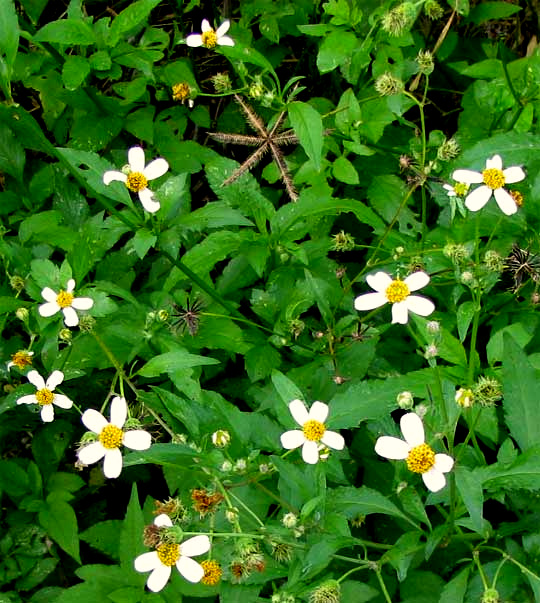
A close-up of a flower head composed of yellow disk flowers and white ray flowers is below:

Lots of composite species present this yellow-eyed, white rayed configuration and it can be hard to distinguish them. However, along with the flowers there are fruiting heads, and those fruits are fairly distinctive, each topped with two spines, as shown below:
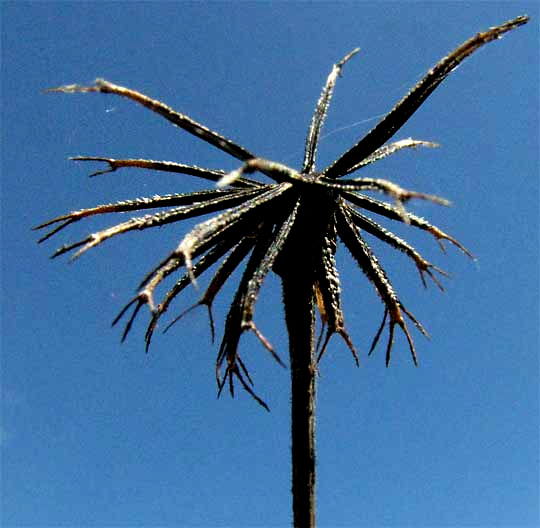
If you're up north and have a dog given to wandering the fields this time of year, surely that dog returns home covered by fruits similar to these, the "stick- tights," "tickseeds" or "Spanish needles" produced by several weedy species of the genus Bidens. I think the one illustrated here is BIDENS ALBA*, earlier lumped with Bidens frondosa.
In the genus Bidens only the disk flowers produce fruits, the peripheral white ray flowers being sterile. The fruits, thought of as seeds by most people, are technically cypselae, which are dry, one-seeded fruits. When you see cypselae topped with two to four stiff, slender bristles, often with the bristles themselves bearing tiny, sharp, backward-pointing spines, a good bet is that your composite is a Bidens. Cosmos produces similar achenes but Cosmos bristles arise from a "beak," or slender stem, atop the main fruit body, while you can see in the last picture that Bidens bristles arise directly from the main body.
from the February 22, 2019 Newsletter issued from Rancho Regensis north of Valladolid, Yucatán, MÉXICO;
elevation ~40m (~130 ft), N~20.876°, W~88.170°
EATING STICK-TIGHT LEAVES
Last week a Canadian herbalist visited the ranch so I could help her learn how to identify plants. She'd just come from upland Chiapas where she'd met the genus Bidens. Apparently herbalists are learning that species of the genus Bidens are exceptionally medicinal, especially for the lungs and mucous membrane protection.
My visitor left some photocopied pages detailing uses of the genus Bidens, and the list was formidable: Antimalarial, antibacterial, antimicrobial, antidysenteric, diuretic, hepatoprotective, hypotensive, anti-inflammatory, hypoglycemic, antidiabetic, styptic, vulnerary, immunomodulant, antiseptic, neuroprotectant, blood tonic, astringent, carminative, galoctogogue, mucous membrane tonic, prostaglandi synthesis inhibitor. It's the "most potent PGE2 plant inhibitor" known, whatever that means.
I'm used to seeing long lists of traditional medicinal uses for species for which lab analysis can't find any support, so I didn't get too excited. However, on the day my friend left I got caught biking in a very unusual chilly rain, and had to wear wet clothing for several hours. That gave me a cold. When the cold got to the lung-clogged, nose-dripping stage I remembered that the genus Bidens was especially good for "lungs and mucous membrane protection." Nothing was said about treating colds, but I knew where several kilometers of weedy roadside were dominated by a species of the genus Bidens, so what the heck?
Several Bidens species are listed for the Yucatan, so when I went to collect my herbage I took pictures of important features, to help in ID later. A flowering branch emerging from a dense tangle of various weed species is shown below:
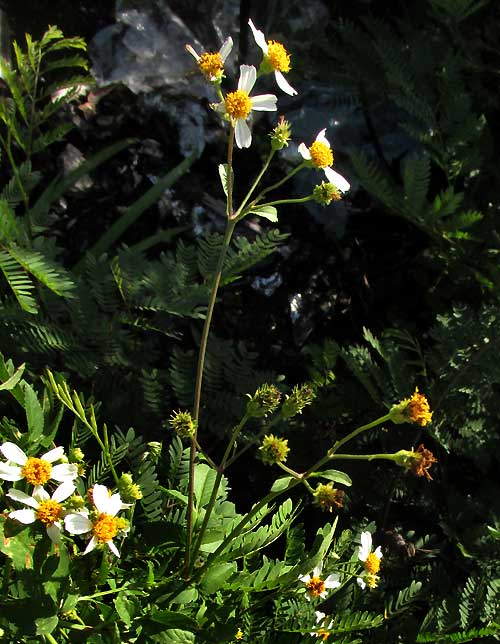
The stems were squared in cross section, with leaves arising opposite one another, and the larger leaves were usually three parted, or trifoliate, as seen below:
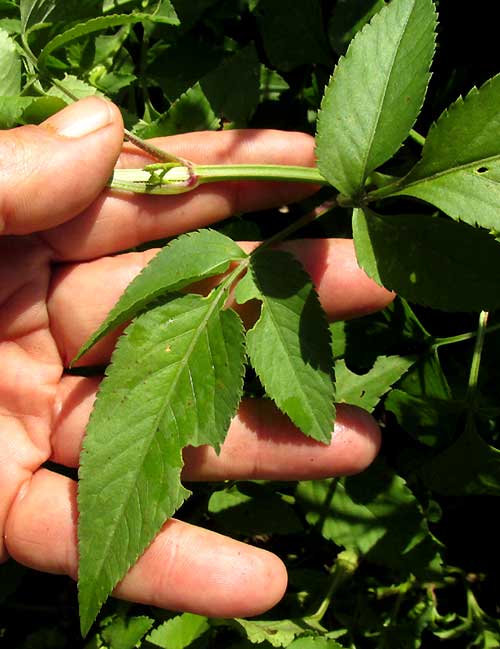
A blossom close-up, displaying classic features of the Aster or Composite Family, the Asteraceae, with white, petal-like ray flowers and yellow, cylindrical disc flowers tightly packed into an "eye," is shown below:
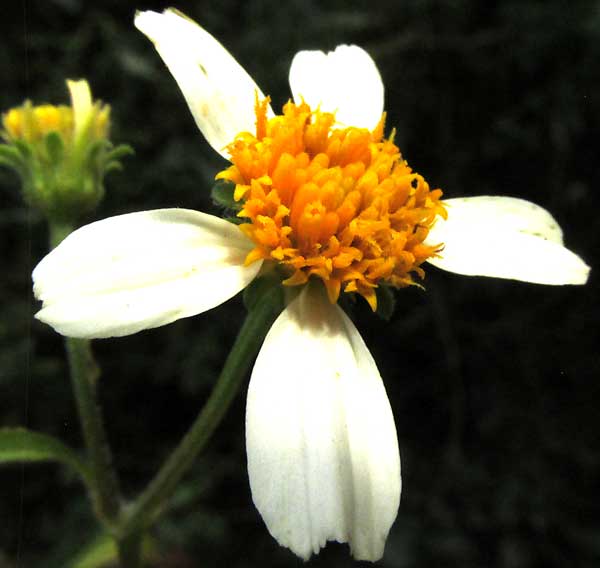
The shape and disposition of green, leafy "bracts" forming a kind of bowl below the head often is important, so that's shown below:
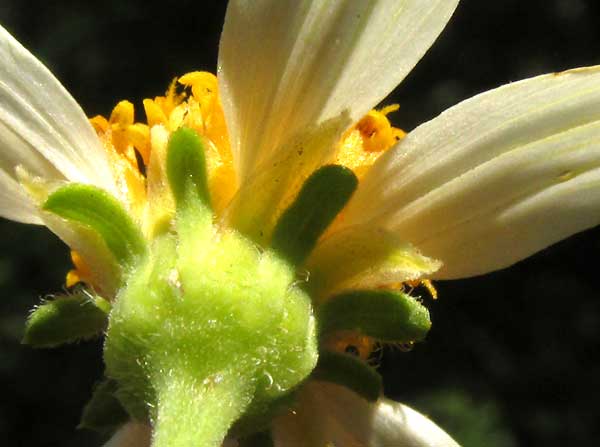
Some of the older heads already had ejected their corollas, leaving only the ovaries developing into classic stick-tight fruits, seen below:
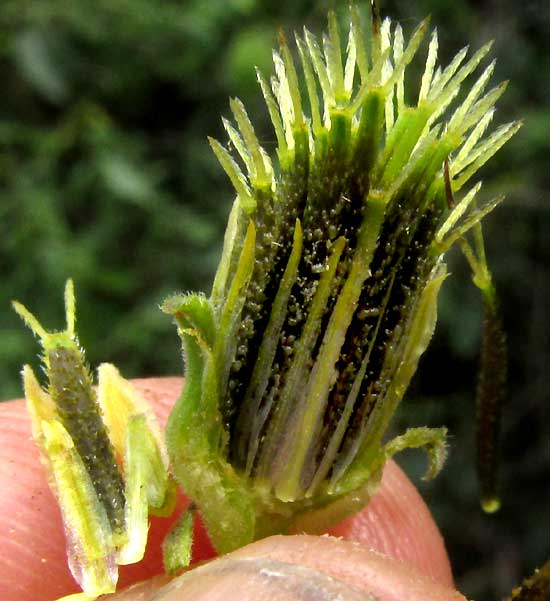
Those details were enough to figure out that this was BIDENS ALBA, a Stick-tight species native from Florida and the Caribbean area south through eastern and southern Mexico to Honduras, and then with another population in northern and western South America. That name suited me fine, because my friend's photocopied pages mentioned Bidens alba as one of the more potent Bidens species.
I'd read on those pages that one problem with using Bidens medicinally is that drying the leaves for storage destroys much of their potency, as does heat. Alcohol extracts are much more effective than watery "teas." There on the highway north of Temozón, my lungs clogged and my nose running, I figured that there wasn't any need to prepare a tincture of the leaves at all. From plants a little away from the road, I grabbed a couple of handfuls of soft, young herbage, and ate them. There was little taste, good or bad. They weren't fibrous or brittle, not good not bad.
Within a couple of hours my nose stopped running and by the time I went to bed my lungs were much improved. Was it the Bidens, or just that time during a cold when the symptoms go away? Or maybe the placebo effect. That's how it always is, one just never knows until it's experienced again and again.
For those up north who think they've seen this plant under the name Bidens pilosa, here's the story:
The Flora of North America lumps our Bidens alba with the common roadside stick-tight in the US, Bidens pilosa, but down here people who know the species best say that they're different, and on this I'm with the Mexicans. They have different chromosome numbers. I find that bracts beneath heads of our Bidens alba are rounded-tipped, while those of Bidens pilosa are narrower and more sharp pointed. {Update: by 2024 I've seen enough to go with those lumping the two taxa into the Bidens pilosa complex}.
One reason that so many Bidens alba plants ornament the roadside north of Temozón is that each plant can produce between 3000-6000 one-seeded fruits, which can remain viable for up to five years.
Interestingly, Bidens alba is super-abundant along the highway north of Temozón, but for the four kilometers between the rancho and Ek Balam there's not a single one. I believe it's because the Temozón highway, being important for commerce, is maintained on a schedule, while locally things are cut back only when enough of the local citizenry make a fuss or there's a wreck. The needs of Bidens are clearly met on the highway north of Temozón, but the species away from the main highway just can't deal with occasional lack of disturbance.